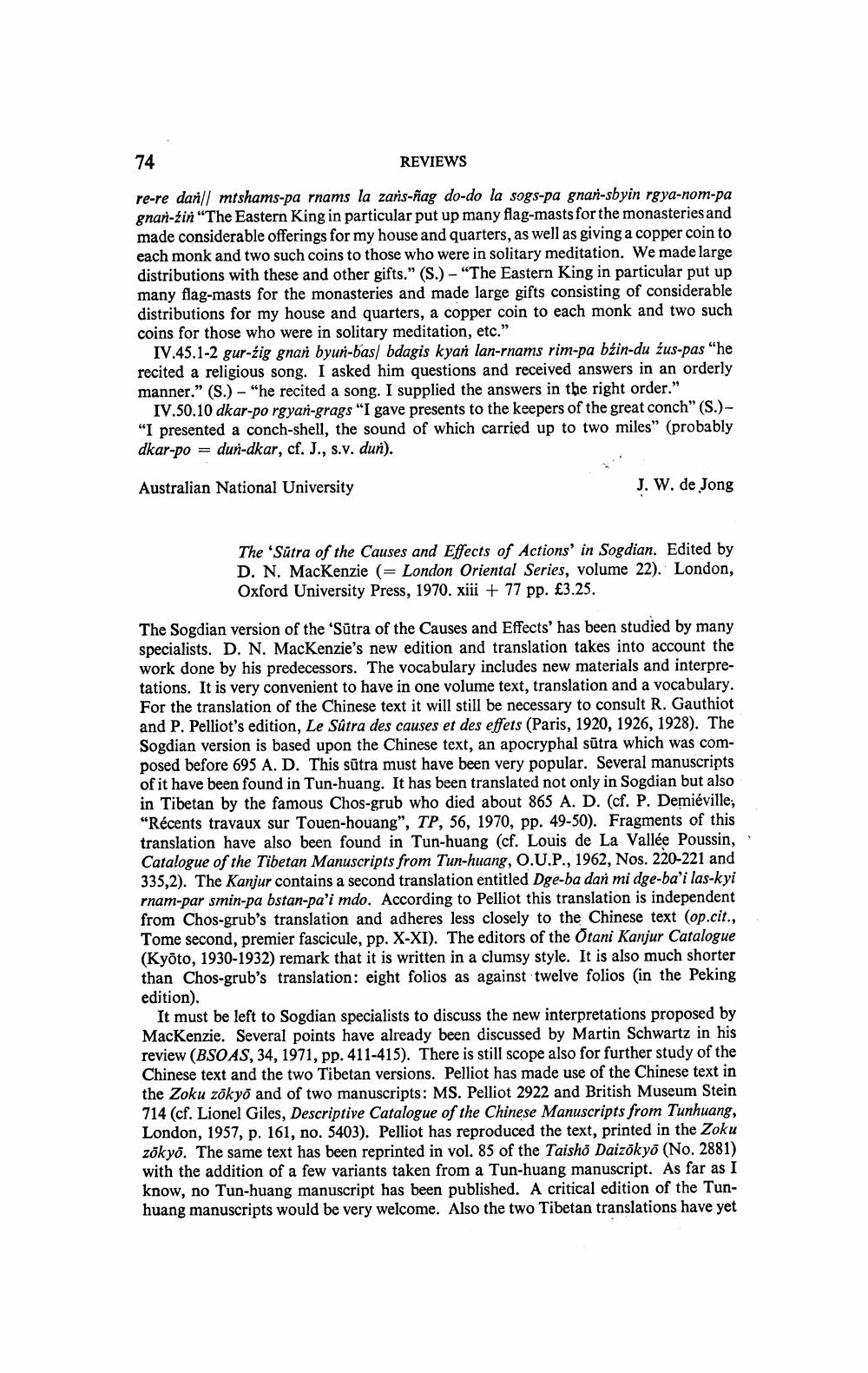________________ 74 REVIEWS re-re dari// mtshams-pa rnams la zans-nag do-do la sogs-pa gnar-sbyin rgya-nom-pa gnar-zin "The Eastern King in particular put up many flag-masts for the monasteries and made considerable offerings for my house and quarters, as well as giving a copper coin to each monk and two such coins to those who were in solitary meditation. We made large distributions with these and other gifts." (S.) - "The Eastern King in particular put up many flag-masts for the monasteries and made large gifts consisting of considerable distributions for my house and quarters, a copper coin to each monk and two such coins for those who were in solitary meditation, etc." IV.45.1-2 gur-zig gnan byur-bas/ bdagis kyan lan-rnams rim-pa bzin-du zus-pas "he recited a religious song. I asked him questions and received answers in an orderly manner." (S.) - "he recited a song. I supplied the answers in the right order." IV.50.10 dkar-po rgyan-grags "I gave presents to the keepers of the great conch" (S.)"I presented a conch-shell, the sound of which carried up to two miles" (probably dkar-po = dur-dkar, cf. J., s.v. dun). Australian National University J. W. de Jong The 'Sutra of the Causes and Effects of Actions' in Sogdian. Edited by D. N. MacKenzie (= London Oriental Series, volume 22). London, Oxford University Press, 1970. xiii + 77 pp. PS3.25. The Sogdian version of the 'Sutra of the Causes and Effects' has been studied by many specialists. D. N. MacKenzie's new edition and translation takes into account the work done by his predecessors. The vocabulary includes new materials and interpretations. It is very convenient to have in one volume text, translation and a vocabulary. For the translation of the Chinese text it will still be necessary to consult R. Gauthiot and P. Pelliot's edition, Le Sutra des causes et des effets (Paris, 1920, 1926, 1928). The Sogdian version is based upon the Chinese text, an apocryphal sutra which was composed before 695 A. D. This sutra must have been very popular. Several manuscripts of it have been found in Tun-huang. It has been translated not only in Sogdian but also in Tibetan by the famous Chos-grub who died about 865 A. D. (cf. P. Demieville, "Recents travaux sur Touen-houang", TP, 56, 1970, pp. 49-50). Fragments of this translation have also been found in Tun-huang (cf. Louis de La Vallee Poussin, Catalogue of the Tibetan Manuscripts from Tun-huang, O.U.P., 1962, Nos. 220-221 and 335,2). The Kanjur contains a second translation entitled Dge-ba dan mi dge-ba'i las-kyi rnam-par smin-pa bstan-pa'i mdo. According to Pelliot this translation is independent from Chos-grub's translation and adheres less closely to the Chinese text (op.cit., Tome second, premier fascicule, pp. X-XI). The editors of the tani Kanjur Catalogue (Kyoto, 1930-1932) remark that it is written in a clumsy style. It is also much shorter than Chos-grub's translation: eight folios as against twelve folios in the Peking edition). It must be left to Sogdian specialists to discuss the new interpretations proposed by MacKenzie. Several points have already been discussed by Martin Schwartz in his review (BSOAS, 34, 1971, pp. 411-415). There is still scope also for further study of the Chinese text and the two Tibetan versions. Pelliot has made use of the Chinese text in the Zoku zokyo and of two manuscripts: MS. Pelliot 2922 and British Museum Stein 714 (cf. Lionel Giles, Descriptive Catalogue of the Chinese Manuscripts from Tunhuang, London, 1957, p. 161, no. 5403). Pelliot has reproduced the text, printed in the Zoku zokyo. The same text has been reprinted in vol. 85 of the Taisho Daizokyo (No. 2881) with the addition of a few variants taken from a Tun-huang manuscript. As far as I know, no Tun-huang manuscript has been published. A critical edition of the Tunhuang manuscripts would be very welcome. Also the two Tibetan translations have yet




